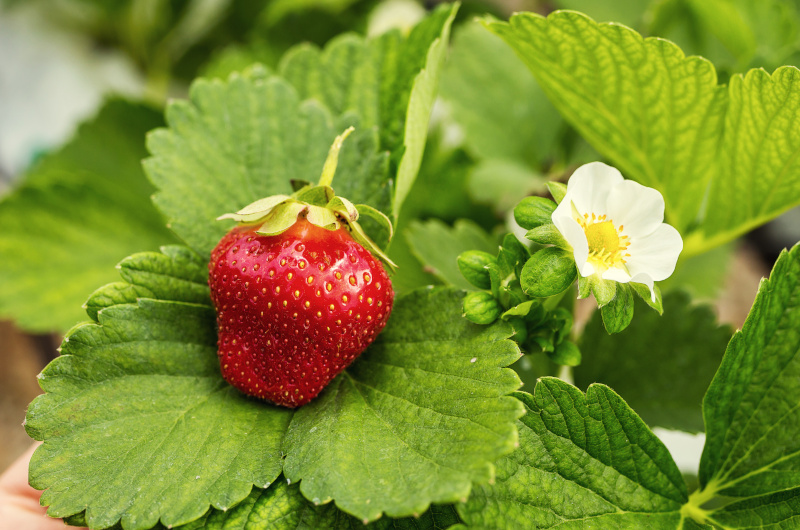How To Grow Strawberries
Strawberries are a delicious and quintessentially British fruit that can be easily grown in your garden. Whether you have a small plot or a spacious backyard, cultivating your own strawberries can be a rewarding and enjoyable experience. In this article, we will provide you with a comprehensive guide on how to successfully grow strawberries in the UK. From selecting the right varieties to caring for your plants, follow these steps to enjoy a bountiful harvest of juicy and flavourful strawberries.
Choosing the Right Varieties:
Before embarking on your strawberry-growing journey, it’s important to select the right varieties suited for the UK climate, as there are many different types available from garden centres and mail order suppliers. Some popular choices include ‘Elsanta,’ ‘Malling Centenary,’ and ‘Cambridge Favourite.’ Consider factors such as taste, disease resistance, and fruiting season when choosing the varieties that best suit your preferences.
As well as conventional crops, there are now “perpetual strawberries” (more properly known as everbearing strawberry varieties) which crop over an extended season, rather than the more usual single crop in early summer. Another option are wild or alpine strawberries (Fragaria vesca) . These are tiny and produce masses of very sweet berries, but I personally find the taste slightly articificial; more like a strawberry flavoured sweet than a natural crop. They’re very popular with kids though!
Site Selection and Soil Preparation:
Strawberries thrive in a sunny spot, so choose a location in your garden that receives full sun for most of the day. Prepare the soil by removing any weeds, rocks, or debris. Strawberries prefer well-drained soil with a pH range of 6.0 to 6.5. Incorporate organic material, such as well-rotted compost or manure, to improve soil fertility and structure and to ensure a big crop.
Strawberries also lend themselves well to planting in pots or hanging baskets. When growing in pots, it’s generally best to opt for a commercially produced strawberry planter, as these usually have planting positions on their sides, maximising the number of plants grown, but only taking up a tiny footprint, which is great if you’ve only got a little space for growing. Growing in pots or baskets also gives easy access for harvesting, without the need for back-breaking kneeling.
Planting Strawberries:
Strawberries can be planted in late summer or early autumn for a crop the following year. Dig holes or create raised beds with spacing of around 30cm (12 inches) between plants. Place the strawberry plants in the holes, ensuring that the crown is level with the soil surface. Gently firm the soil around the plants and water thoroughly.
Providing Optimal Growing Conditions:
Strawberries require consistent moisture to thrive. Water the plants regularly, aiming to keep the soil moist but not waterlogged. Mulch around the plants with straw or wood chips to help retain moisture, suppress weed growth, and protect the developing fruits from direct contact with the soil.
Fertilising, Feeding and Watering:
To ensure healthy growth and abundant fruiting, fertilise your strawberry plants. Apply a balanced organic fertiliser in early spring, following the recommended dosage on the packaging. Additionally, provide a potassium-rich liquid feed every two to three weeks during the fruiting season to promote larger, sweeter berries. Whilst a general fertiliser will suffice, dedicated strawberry fertilisers will help maximise crops.
Strawberries are made up of around 92% water, so it’s critical to keep watering well once berries start to appear, to ensure they flourish into a big, juicy crop, but it’s better to keep them moist with regular watering, rather than heavily saturating the plants.
Weed Control and Pest Management:
Keep the strawberry bed free from weeds to minimize competition for nutrients and water. Regularly remove weeds by hand, taking care not to disturb the shallow strawberry roots. Protect your plants from pests such as slugs, snails, and birds by using organic pest control methods or physical barriers, such as netting.
Strawberries Care and Runner Removal:
Strawberries produce runners, which are long stems that develop from the mother plants and produce new baby plants. Allow a few runners to root and establish new plants where possible, as older plants will lose their vigour over a few seasons. By refreshing plants every few years, you can ensure good crops for years to come. However, excessive runners can lead to overcrowding and reduced fruit production. Regularly remove excess runners to maintain proper spacing between plants. As a general, it tends to be best to remove all but a single runner from each parent plant, so that a new plant establishes quickly and grows large enough to survive the coming winter.
Harvesting Strawberries:
Strawberries are ready to be harvested when they have fully ripened and turned a deep, vibrant colour. Pick the ripe strawberries by gently twisting the fruit off the stem, leaving the green calyx intact. Harvest in the morning when the berries are cool and firm. Enjoy your freshly picked strawberries immediately or store them in the refrigerator for a short period.
Growing strawberries in your British garden is a delightful and rewarding endeavour. By following these steps, you can cultivate healthy plants and enjoy the taste of juicy and flavourful strawberries straight from your own garden. Remember to choose the right varieties, prepare the soil properly, provide optimal growing conditions, and maintain regular care for a successful strawberry harvest.



